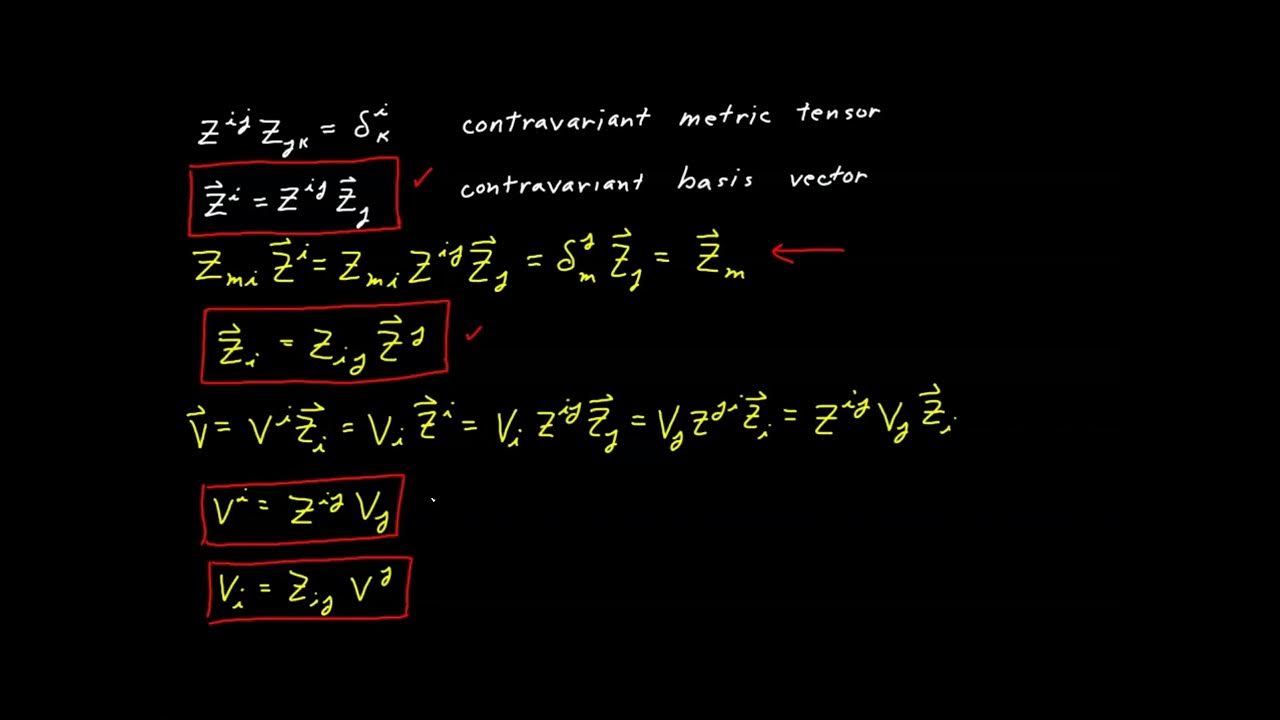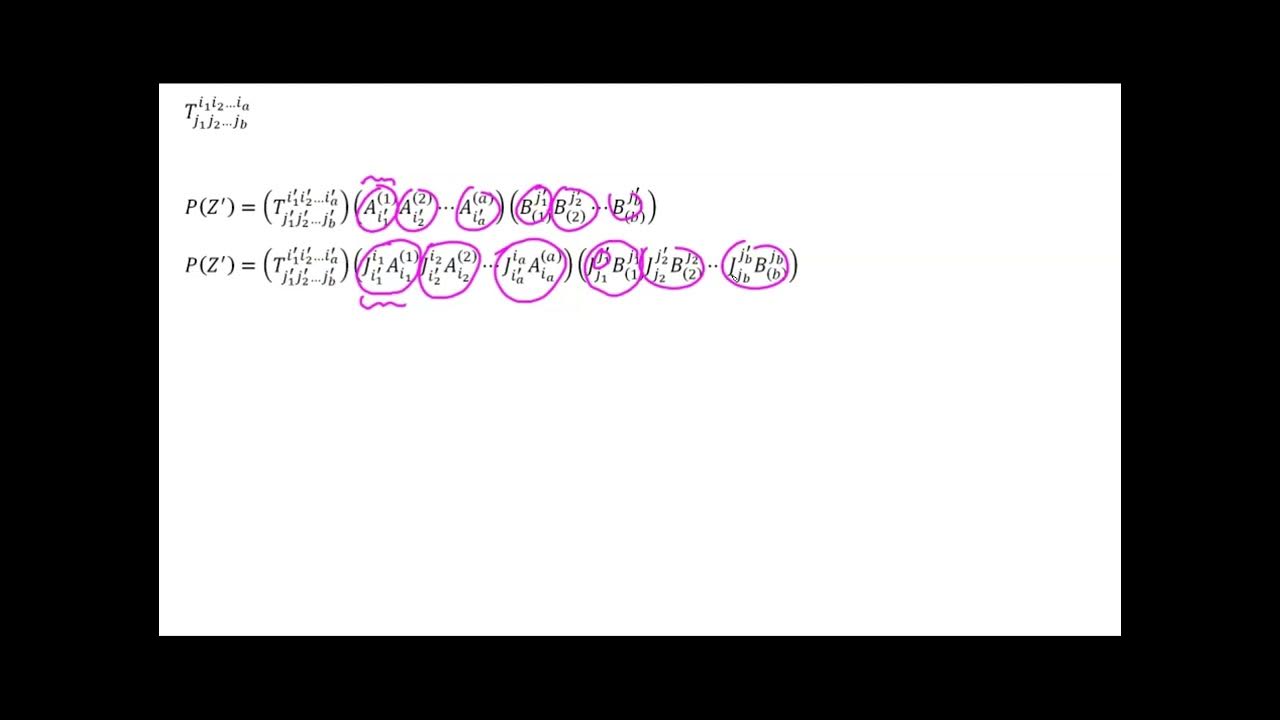Tensor Operations: Contractions, Inner Products, Outer Products
TLDRThis educational video delves into advanced tensor operations, building on the definition and transformation laws from a previous session. It explains tensor contraction, which reduces tensor rank by summing over shared indices, using a 2x2 tensor example for clarity. The video also covers the inner product of tensors, demonstrating its invariance through an example with contravariant and covariant vectors, resulting in a scalar. Lastly, it introduces the outer product, detailing how it combines tensors without index summation, thus increasing the rank. The lecture aims to solidify the understanding of these tensor operations with practical examples and a commitment to mathematical precision.
Takeaways
- 📚 The video continues the discussion on tensor operations, building upon the definition and transformation laws introduced in a previous video.
- 🔍 Tensors are defined by their transformation laws, with contravariant and covariant ranks indicated by superscripts and subscripts, respectively.
- 🤔 The contraction operation is explained as a 1-tensor operation that involves summing over a repeated index after replacing two different indices with the same one.
- 📉 Contraction results in a tensor with reduced contravariant and covariant ranks by one each, due to the summation over a dummy index.
- 🧠 An example of contracting a 2x2 tensor is provided to illustrate the concept, resulting in a 1:1 tensor or scalar.
- 🤝 The inner product of two tensors is introduced, which combines them by equating chosen contravariant and covariant indices and summing the product of their components.
- 📊 The rank of the inner product tensor is the sum of the individual tensor ranks minus two, reflecting the loss of two indices due to the summation.
- 📚 An example demonstrates that the inner product of a contravariant and covariant vector results in a scalar invariant, proving the invariance theorem mentioned earlier.
- 🔗 The outer product is defined as the product of components of two tensors without summing over any index, thus increasing the rank of the resulting tensor.
- 📈 The rank of an outer product tensor is the sum of the ranks of the individual tensors, with contravariant and covariant ranks being the sums of the individual tensor ranks.
- 📝 The video script clarifies various terminologies for the outer product, such as Kronecker product, tensor product, and direct product, and commits to using 'outer product' in the context of tensors.
Q & A
What is the main focus of the video script?
-The main focus of the video script is to discuss tensor operations, including contraction, inner product, and outer product, and how they affect the transformation laws and ranks of tensors.
What is the difference between a contravariant and a covariant tensor?
-A contravariant tensor has its indices in the superscript, indicating the tensor's contravariant rank, while a covariant tensor has its indices in the subscript, indicating its covariant rank.
What is a contraction in the context of tensors?
-A contraction is a tensor operation that involves summing over a common index of a tensor, effectively reducing the tensor's rank by one for both contravariant and covariant indices.
Can you provide an example of tensor contraction?
-An example of tensor contraction is given with a 2x2 tensor with indices i1, i2, j1, and j2. Contracting with respect to i2 and j1 involves summing over a common index, resulting in a 1:1 tensor.
What is the transformation law for a tensor?
-The transformation law for a tensor describes how the tensor components change under a coordinate transformation, with unbarred components being in the original coordinate system and barred components after the transformation.
How does the rank of a tensor change after an inner product operation?
-The rank of a tensor after an inner product operation is the sum of the ranks of the individual tensors minus two, due to the summation over two indices, one contravariant and one covariant.
What is the Kronecker Delta function, and how is it related to the inner product of vectors?
-The Kronecker Delta function is a function that is equal to 1 when its two indices are equal and 0 otherwise. It is related to the inner product of vectors because the product of partial derivatives in the transformation law for vectors results in the Kronecker Delta, which simplifies the inner product to a scalar invariant.
What is the outer product of two tensors, and how does it affect the rank of the resulting tensor?
-The outer product of two tensors is a tensor whose components are the product of each component of the first tensor with each component of the second tensor. The rank of the resulting tensor is the sum of the ranks of the individual tensors, as no indices are summed over.
Can you give an example of an outer product of two vectors?
-An example of an outer product is given with contravariant vector a = [a1, a2, a3] and covariant vector b = [b1, b2, b3]. The outer product results in a rank 2 tensor, which can be expressed as a matrix with elements a_i * b_j.
What are some alternative terms for the outer product of tensors?
-Alternative terms for the outer product of tensors include Kronecker product, tensor product, and direct product. These terms are sometimes used interchangeably but can have different contexts in various sources.
Outlines
📚 Tensor Operations Overview
This paragraph introduces the topic of tensor operations, building on the previous video's definition of tensors and their transformation laws. It sets the stage for a deeper dive into specific tensor operations such as contraction, inner product, and outer product. The paragraph explains the basic setup for discussing these operations, involving two tensors 's' and 'T' with their respective contravariant and covariant ranks. It also introduces the concept of tensor components in different coordinate systems and the transformation between them.
🔍 Detailed Exploration of Tensor Contraction and Inner Product
This paragraph delves into the specifics of tensor contraction and inner product. Contraction is described as a one-tensor operation that reduces the rank of a tensor by summing over a contravariant and covariant index. An example is given to illustrate this with a 2x2 tensor, resulting in a 1:1 tensor or scalar. The inner product is then discussed, explaining how it combines two tensors by equating a contravariant index from one tensor and a covariant index from another, leading to a new tensor of rank P+R+Q+S-2. An example using contravariant and covariant vectors is provided to demonstrate that the inner product results in a scalar invariant, confirming a previous theorem about tensor invariants.
🌐 Understanding Outer Product and Tensor Ranks
The final paragraph focuses on the outer product of two tensors, explaining its definition and how it differs from the inner product by not summing over any indices, thus preserving the rank. The rank of the outer product is the sum of the ranks of the individual tensors involved. An example of the outer product of two vectors is given, resulting in a rank 2 tensor expressed as a matrix. The paragraph also clarifies various terms used interchangeably for the outer product in different contexts, such as Kronecker product, tensor product, and direct product, opting to use 'outer product' consistently in the context of tensors.
Mindmap
Keywords
💡Tensors
💡Contravariant Rank
💡Covariant Rank
💡Transformation Laws
💡Contraction
💡Inner Product
💡Outer Product
💡Kronecker Delta
💡Invariants
💡Rank
💡Coordinate Systems
Highlights
Introduction to tensor operations, building on the definition of tensors using transformation laws.
Explanation of tensor contraction as a 1-tensor operation involving summation over repeated indices.
Illustration of tensor contraction with a 2x2 example tensor to demonstrate the concept.
Reduction of contravariant and covariant ranks by one due to index summation in contraction.
Clarification that the term 'prime' in tensor contraction denotes contraction, not transposition.
Introduction of the inner product of tensors, requiring matching contravariant and covariant indices.
Description of the inner product's resulting tensor rank as the sum of the ranks minus two.
Example of the inner product between a contravariant vector and a covariant vector resulting in a scalar.
Proof of the invariance of the inner product of a contravariant and covariant vector.
Introduction of the outer product of tensors, combining tensors without summing over indices.
Explanation of the outer product resulting in a tensor whose rank is the sum of the individual tensor ranks.
Demonstration of the outer product of two vectors resulting in a rank 2 tensor expressed as a matrix.
Discussion on the various terms used for the outer product, such as Kronecker product and tensor product.
Emphasis on the use of 'outer product' to refer exclusively to the tensor product in the context of tensors.
Acknowledgment of patrons supporting the video and invitation for viewers to engage with the content.
Transcripts
5.0 / 5 (0 votes)
Thanks for rating:





